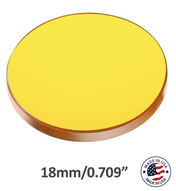Introduction
CO2 laser technology has revolutionized various industries, from manufacturing to medical procedures. A key component of CO2 laser systems is the lens, which plays a crucial role in shaping the laser beam for optimal performance. In this blog, we'll delve into the different types of CO2 laser lenses and their applications across various industries.
Plano-Convex Lenses:
The plano-convex lens is a fundamental type used in CO2 laser systems. With one flat surface and one outwardly curved surface, this lens focuses the laser beam to a single point, allowing for precise cutting, engraving, and marking. The plano-convex lens is an excellent choice for applications requiring high power density and fine detail.
Applications: Laser engraving, cutting intricate patterns, and microfabrication.
Meniscus Lenses:
Meniscus lenses have one convex and one concave surface. These lenses are designed to reduce spherical aberration and provide a better focus, resulting in improved beam quality. Meniscus lenses are often used in situations where beam quality and focusing accuracy are paramount.
Applications: Medical device manufacturing, high-precision cutting, and laser drilling.
Plano-Concave Lenses:
With one flat and one inwardly curved surface, plano-concave lenses diverge laser beams instead of focusing them. This type of lens is used to expand the laser beam's diameter, making it useful for applications requiring wide coverage.
Applications: Laser annealing, heat treating, and large-scale surface treatments.
Cylindrical Lenses:
Cylindrical lenses have a curved surface along one axis and a flat surface along the perpendicular axis. These lenses are utilized to reshape the laser beam into an elliptical shape, transforming round beams into lines or rectangles.
Applications: Material scribing, glass cutting, and beam shaping for industrial processes.
Aspheric Lenses:
Aspheric lenses have a more complex curvature than traditional spherical lenses. They help minimize aberrations and improve focus, resulting in higher precision and sharper edges in laser processes. Aspheric lenses are known for their ability to correct distortions and improve beam quality.
Applications: Medical surgery, electronics manufacturing, and precision welding.
Zoom Lenses:
Zoom lenses allow for adjustable focal lengths, providing versatility in changing working distances and beam sizes. These lenses enable operators to adapt the laser system to different tasks without physically changing lenses.
Applications: Prototyping, research, and applications requiring quick adjustments.
Conclusion
CO2 laser lenses come in various types, each designed to suit specific applications and requirements across industries. From fine engraving to high-power cutting, the right choice of lens can significantly impact the quality, efficiency, and precision of CO2 laser processes. By understanding the characteristics and applications of different CO2 laser lenses, professionals can make informed decisions about selecting the optimal lens for their specific tasks.
Whether you're crafting intricate jewelry designs or manufacturing precision medical devices, the world of CO2 laser lenses offers a diverse range of options to cater to your unique needs.






